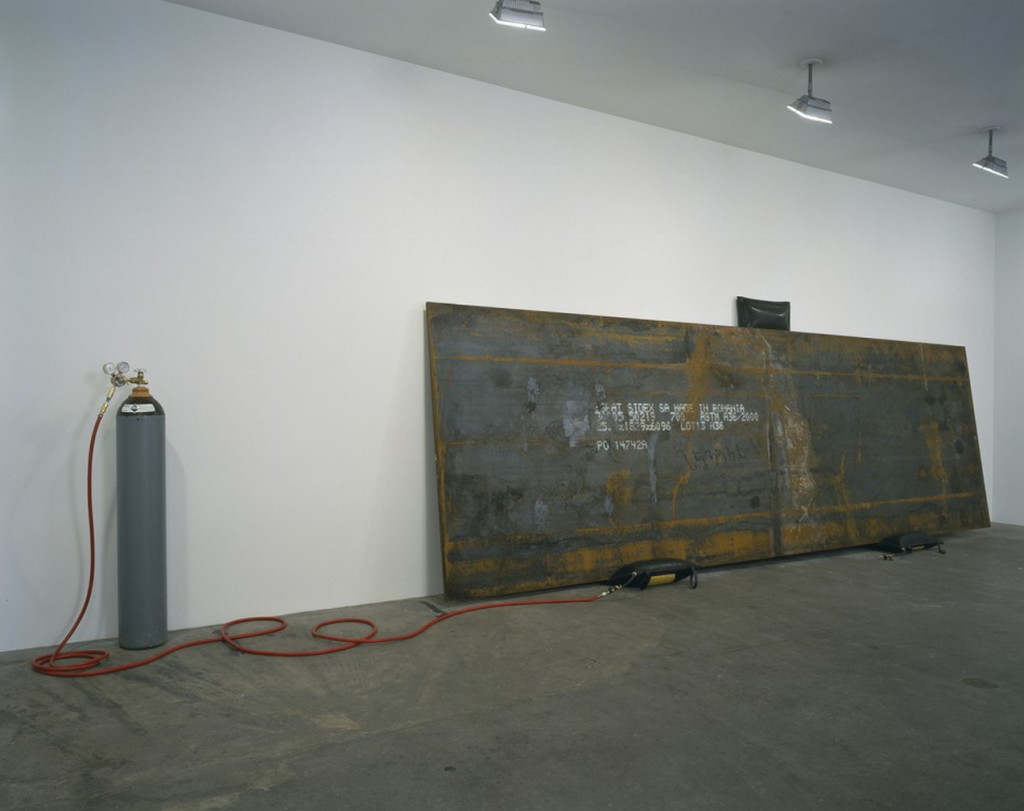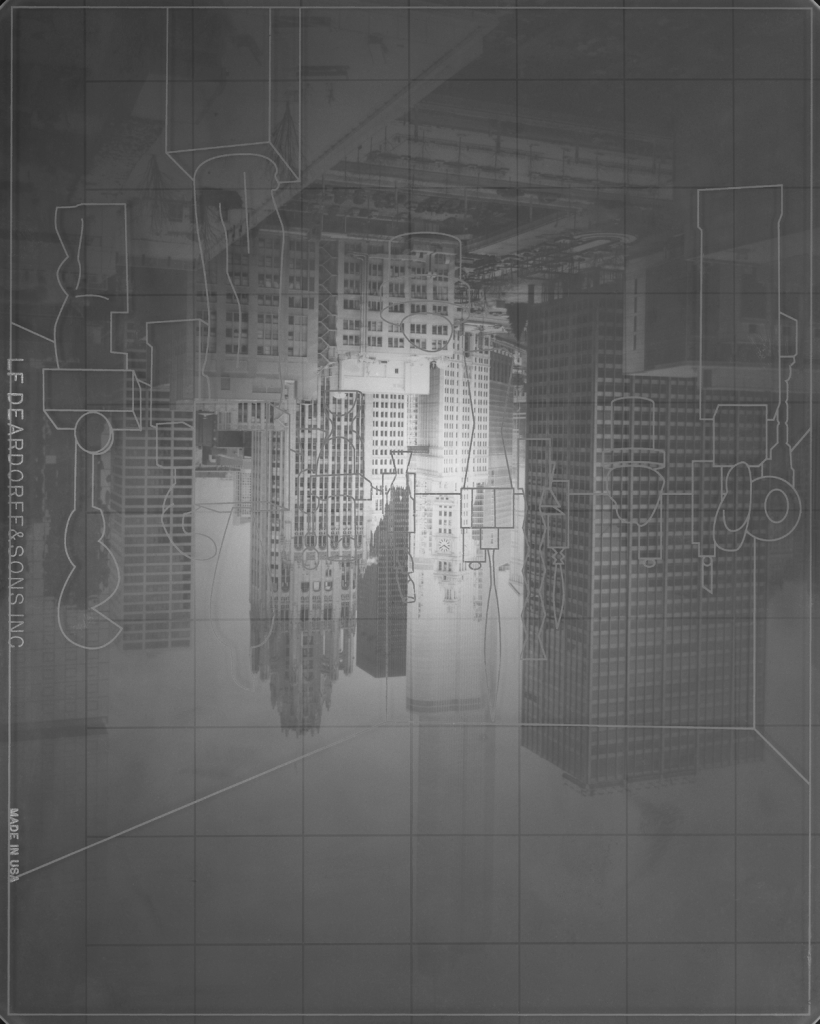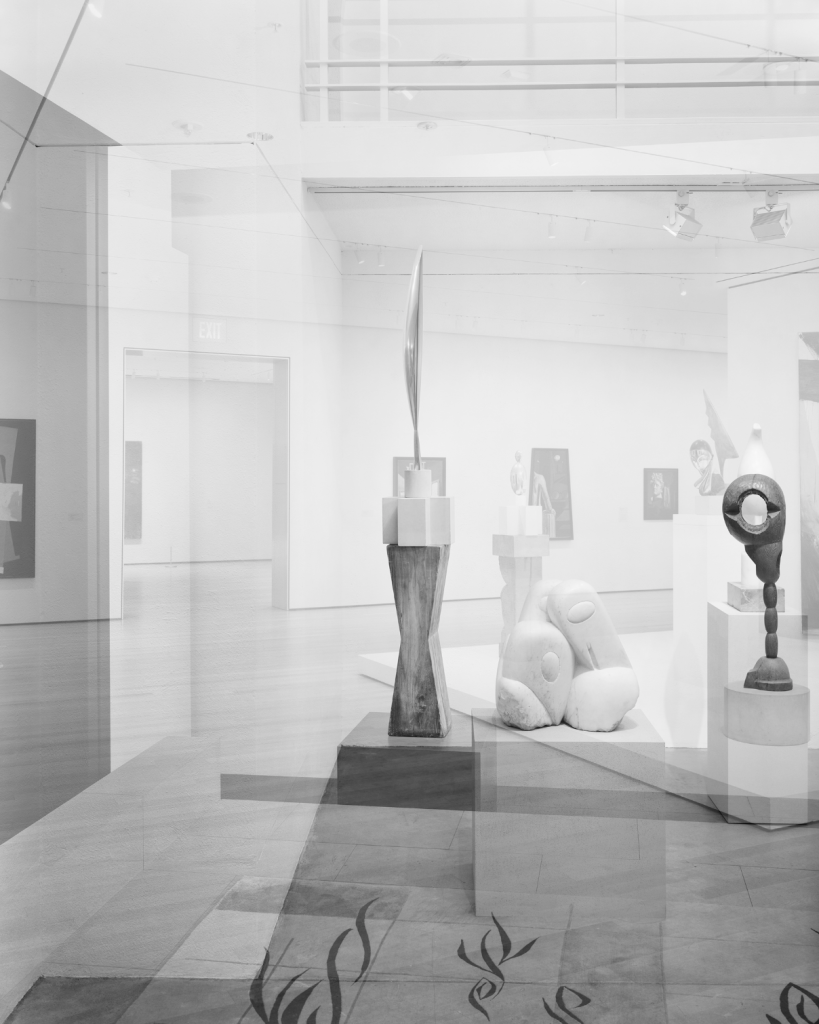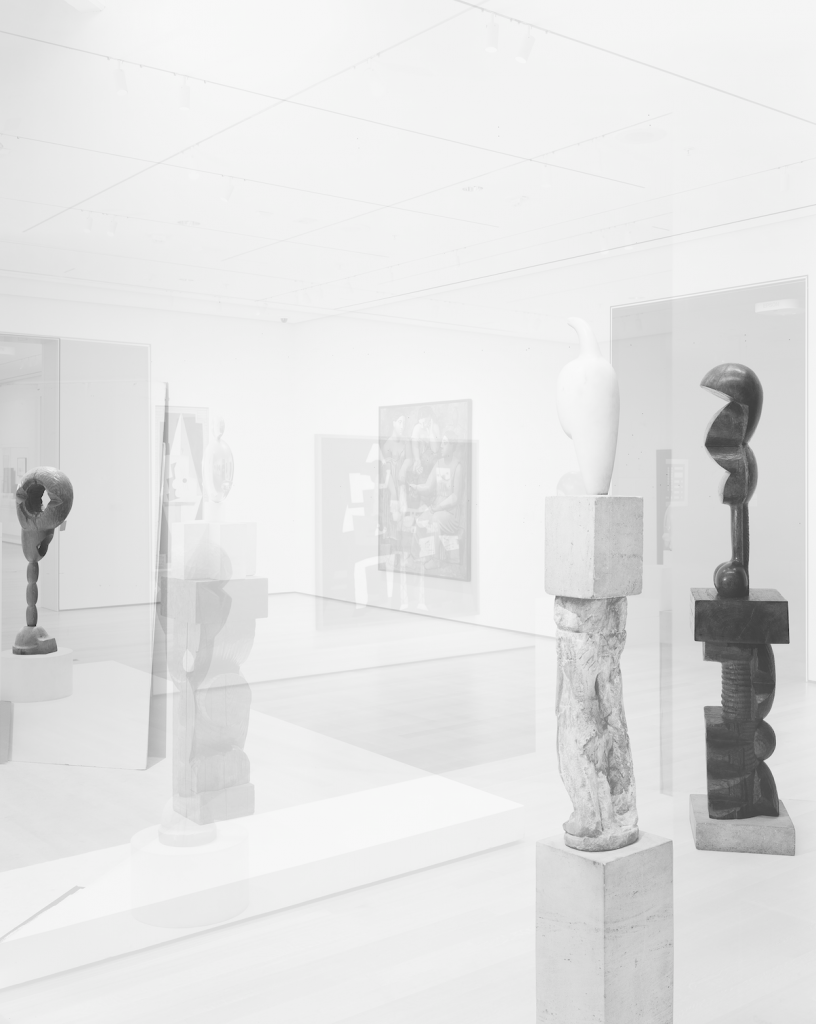Simon Starling: Pictures for an Exhibition
The Arts Club of Chicago
201 E. Ontario Street, Chicago, IL 60611
June 6–September 26, 2014
Simon Starling: Metamorphology
Museum of Contemporary Art Chicago
220 E Chicago Ave Chicago, IL 60611
June 7–November 2, 2014
By Amanda Roscoe Mayo
Simon Starling of Great Britain and Turner Prize fame has finally landed on U.S. soil with a considerable exhibition of work through collaboration between the Museum of Contemporary Art and The Arts Club of Chicago. The MCA’s installation, “Metamorphology” includes a true survey of Starling’s recent work while the Arts Club of Chicago, “Pictures for an Exhibition,” presents a newly commissioned project.
Part I: Metamorphology

Simon Starling, “Autoxylopyrocycloboros,” 2006. 38 color transparencies, Götschmann medium format slide projector, and flight case. 4 minutes. Projected dimensions variable. Courtesy of the artist and the Modern Institute, Glasgow.
Simon Starling’s solo survey of work at the Museum of Contemporary Art proves to be an excellent introduction to the artist’s practice for his first major exhibition in the United States. Each work is heavy with meaning and more often than not requires support beyond a footnote. The show has taken up residence in five rooms on the first floor of the MCA. Working in a circle the viewer begins and ends with light. Upon first glance the space is strategically hung with materials, curious objects that might not register as significant. As a translator of history Starling offers context and to-the-point explanation in his personally written wall texts accompanying the title of each piece. “The Long Ton” (2009), a work of much gravity, hangs eerily still above the floor. It consists of two pieces of marble, one originating from China and the other cut to the exact complementary dimensions of the marble’s weight from Carrara, Italy. The Italian marble is clearly smaller in size than the Chinese piece, however its weight is the same, an objective highlighted by their hanging in tandem above the museum floor.
Easing into the darkness one is met by a small projection of “Z1,” “the world’s first programmable computer,” developed in 1936 by Konrad Zuse, an engineer and artist. The wall text accompanying this work is the most difficult to follow of Starling’s usually accessible writing, but I suspect that is due to my almost nonexistent knowledge of computer technology or technology in general. Nonetheless, what we are actually looking at is a 35mm moving picture on a Dresden D1 projector. The picture looks like a motherboard, which I believe is being programmed. The choice to screen this small but significant film on a rather assuming piece of midcentury equipment originating from the same country inflates this work’s status as object. The story itself could feasibly be enough, but once again Starling’s use of conduit is what stops us in our tracks offering a visual many have never laid eyes upon.
In the darkest room “Autoxylopyrocycloboros” (2006) is projected on a dated medium format slide projector. The transparencies move like that of a film chronicling the artist and an assistant on a boat powered by a wood-burning steam engine. The wooden boat is slowly dismembered as fuel until it meets its demise in the frigid waters of the Loch Long. This work is one of the scarce times we see the artist in a performative role, which is necessary for this particular narrative to provide that “a-ha” moment Starling delivers with each piece. “Autoxylopyrocycloboros” is deeply layered beginning with the most basic fact that the steam engine was invented on Loch Long. Along a particular shoreline of Loch Long the home base for a now infamous peace camp resides, made up of protestors interested in uncovering the secret activities of Faslane and Coulport naval bases. This information coupled with the absurdity of the performance itself marks the significance of the artist’s presence in this work in addition to the importance of the documentation being in slide form rather than video. Traditionally, before the world of iPhones, still imagery, signage, and voice through text were the most effectively documented moments of protests. While it moves like a film, the silence of the scene and the noise from the projector force us to read these moments with the information provided by Starling.

Simon Starling, detail view, “The Hat Maker/Henry Moore” from “Project for a Masquerade (Hiroshima),” 2010–11. 16 mm film transferred to digital (25 minutes, 45 seconds), wooden masks, cast bronze masks, bowler hat, metals stands, suspended mirror, suspended screen, HD projector, media player, and speakers. Dimensions variable. Rennie Collection, Vancouver. Mask maker: Yasuo Miichi, Osaka. Photo: Ruth Clark.
Without argument the most iconic work in “Metamorphology” is “Project for Masquerade (Hiroshima).” In the largest gallery space of the exhibition is a screen projecting a Japanese mask artisan making masks of James Bond, Anthony Blunt, Colonel Sanders, Joseph Hirshhorn, and others presumably to be used in a play. That play being “Eboshi-Ori” a traditional Japanese tale in which a young nobleman uses a disguise to escape his troubled past. On the other side of the projection screen the masks and Henri Moore’s hat are displayed in the darkness on rods at about eye level, each bathed in a dim spotlight mimicking a stage. This work, as Starling explains in the wall text, was made in response to Henri Moore’s sculpture “Nuclear Energy” on University of Chicago’s campus in Hyde Park. Moore’s piece was commissioned to commemorate the first successful nuclear fission, which took place on campus in 1941 and we now know it as the birthplace for the Manhattan Project. Small artist proofs of Moore’s large sculpture were made in an edition of six and the Hiroshima Museum of Contemporary Art holds one in their collection. The characters in Starling’s play all relate back to Henri Moore and the Cold War Saga in a complicated entangled web, which is not expanded upon. In a way, these factoids are not important because the weight of this work is felt in the viewing of ancient techniques used to make these masks and the ability to see the finished product knowing what this play could be.

Simon Starling, “Bird in Space,” 2004. Imported Romanian steel plate, inflatable jacks, and helium. Steel: 72 x 240 x 1 in. (182.9 x 609.6 x 2.54 cm) Seattle Art Museum. Image courtesy of the artist and Casey Kaplan, New York.
In the final room entering back into a well-lit space are many curious objects, the largest of which relates directly to Starling’s sister show at the Chicago Arts Club. “Bird in Space” is titled after Brancusi’s work of the same name and is a piece of industrial steel from Romania. Brancusi’s “Bird in Space” (1926) encountered a large tax when it was imported by Edward Steichen. Customs declared it as a “metal utensil” rather than a work of art. In 2002 a law was passed by George W. Bush citing that all imported steel must have a 40% tariff applied—with this work, Starling traces the steps of the Brancusi in order to contest what may be declared as an art object or an industrial one. He eventually won his case and the steel was not taxed, whereas Steichen had to go to trial to fight for the integrity of the original “Bird in Space” as an art object. Starling’s “Bird in Space” is elevated from the museum floor and wall using three black pillow-like objects inflated with helium. The steel has not been treated with any kind of artistic gesture, the original text identifying its industry is in tact, and the helium jacks are in their original state a further gesture towards the economics involved in what we think of as art in the contemporary sphere.
Objects imbued with their own story are of utmost importance to Starling’s use of tension whether it be historical relevance or antiquated technology. He culls the soul of the thing and presents it as a finding. The narrative’s true concern deals with economies and commerce whether of a monetary or cultural nature. “Metamorphology” presents an excellent first look at Starling’s work allowing the artist to open our minds and provide the right questions towards a path of discovery.

Simon Starling, “Bicycle Wheel (Failed),” 2003–04. Platinum/palladium print
12 5/8 x 10 1/4 in. (32 x 26 cm). Courtesy of the artist and Casey Kaplan, New York.
Part II: Pictures for an Exhibition
In this commissioned body of work by the Arts Club of Chicago Simon Starling acts as an architect of history, selecting bricks of information to build a wonderfully intricate structure. The artist chose to use Brancusi as a departure point and did what he does best, follow the conceptual threads of modernism to track down the truths in provenance. The origin of this exhibition comes from two installation photographs of the nineteen works in the Constantin Brancusi exhibition at the Arts Club of Chicago overseen by Duchamp in 1927. From these images Starling connects the dots from 1927 to now. This project was an enormous undertaking that only an artist could produce with such elegance and with the support of an institution such as the Arts Club. The framework of the project is built from installation photographs of the 1927 show. Starling traced the objects from those photographs as they were installed and translated the drawing to the glass backing of one of two Deardorff large format cameras, replicas of the original cameras used to capture these images. Another, of the same model, camera was left unaltered and used to document the process. The artist then traveled all over the United States and abroad tracking down the works from the 1927 exhibition aligning them with the outline of their position in the original images and photographed them in their current location.

Simon Starling, “Pictures for an Exhibition,” 2014. 20″ x 24″ silver gelatin print. Modified Deardorff 8×10 Field Camera photographing Constantin Brancusi, “Beginning of the World” (c. 1920). Collection: Dallas Museum of Art. Courtesy of the artist, Casey Kaplan Gallery and Artist Rights Society.
The images then consist in three forms: the images of the original works aligned with the drawing of the 1967 exhibition, the documentation of the making of this image, and the photographs taken by Starling of ancillary materials related to the provenance of each sculpture. A subtle distinction is made between these depictions in the framing. While one could refer to the informative booklet for the definitive content found in each photograph the sophisticated hang of this exhibition allows for differentiation and contemplation from the viewer. The most directly “finished” images, those Starling set out to make using the drawing of the original installation, are framed, matted, and glazed. The documentation images in which the other camera is in the plane is glazed but not matted. Lastly, the anecdotal images that uncover wisps of the story surrounding a sculpture are framed but not matted or glazed. The attention to the presentation of these images indicates the role of each portion of this project challenging traditional display of photography while outlining the category of importance of each photograph.
There are two significant moments that occur in this project for the viewer. The first arrives when one has to ask the question, why do this? This question of course is for those less inclined to be art history buffs and for those for whom the answer is clear: these artworks made by the incomparable Brancusi have an incredibly rich story in terms of who owned them and when—these items are without question significant. The other answer to the “why” for those less versed in modernism lies in the shadow attached to these objects. The shadow holds all that is precious; it is not what is significant about the work as an artwork, but rather what carries the cultural history. Each time a work passed through another’s hands, or on to a new exhibition, it gained a chapter in its story. Starling signifies both the unarguable importance of each Brancusi work along with its story of survival, a rare and intimate look at a biography seldom known.

Simon Starling, “Pictures for an Exhibition,” 2014. Modified Deardorff 8×10 Field Camera photographing the Wrigley Building, Chicago. 20″ x 24″ silver gelatin print. Courtesy of the artist, Casey Kaplan Gallery and Artist Rights Society.
The way in which Starling has provided the information surrounding each image is through a booklet mapping the photographs in the exhibition. Each image has key information and is often accompanied, more often than not, by a “note” containing additional information provided by the artist. These notes are as significant to the show as the objects themselves because they give us the artist’s perspective. Out of all the facts and relevant information he has discovered, this is what he deems as most important. This information is, in part, what separates this project as an artwork rather than a research-based photo essay. Starling investigates prominent people and traces the commerce surrounding the sculptures relating back to his practice, which often centers on the relationship of culture to history in terms of narrative, but also as enunciated through economics and demographics.

Simon Starling, “Pictures for an Exhibition,” 2014. 20″ x 24″ silver gelatin print. Constantin Brancusi, “Bird in Space” (1926), “Three Penguins” (1911-12) and “Socrates” (1922) (from left to right). Collections: John Shirley, Seattle, Philadelphia Museum of Art, Pennsylvania and The Museum of Modern Art, New York. Courtesy of the artist, Casey Kaplan Gallery and Artist Rights Society.
Artworks have a unique ability to follow their own commerce. While cultural significance often does not align with monetary value, Starling has provided a look into both sides of this coin and given us a reminder that art has many ambassadors. This exhibition is one of the few times that research is synthesized correctly into an aesthetically smart and accessible project. It certainly takes work—with the aid of the thorough booklet each viewer may gain the knowledge associated with each photograph. However, this is one of those rare instances when we are thrilled to fall into Starling’s rabbit hole, knowing that what lies on the other side is wonderful.
The presence of these two separate exhibitions affords a unique experience of an artist’s work seldom seen. Each institution has spoken to its own strengths through these shows. The MCA presented a thoughtful and diverse survey of Starling’s work, the first in the United States and long overdue, while The Arts Club of Chicago gave the artist the support and resources to create something entirely new. The opportunity is then a chance to truly see where Starling has come from and what he is dedicated to doing while simultaneously creating a body of work significant not only to Art History, but to Chicago.

Simon Starling, “Pictures for an Exhibition,” 2014. 20″ x 24″ silver gelatin print. Constantin Brancusi, “Socrates” (1922) “Maiastra” (1910-12) and “Adam & Eve” (1916-21) (from left to right). Collections: Museum of Modern Art, New York, The Guggenheim Museum, New York. Courtesy of the artist, Casey Kaplan Gallery and Artist Rights Society.
For more information, visit the Museum of Contemporary Art Chicago and the Arts Club Chicago.
Previous contributions by Amanda Roscoe May include:
Review: Nicholas Gottlund, “Always,” at Paris London Hong Kong, Chicago



